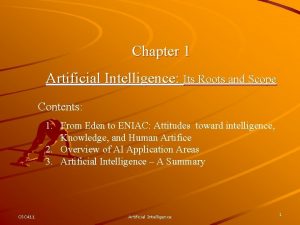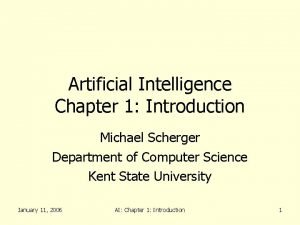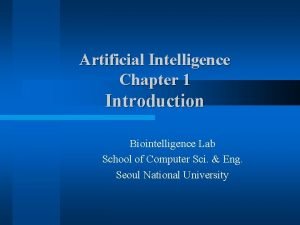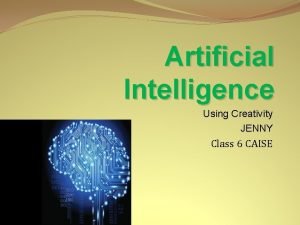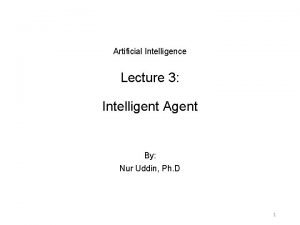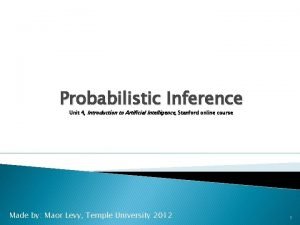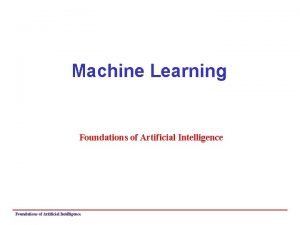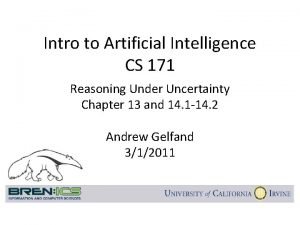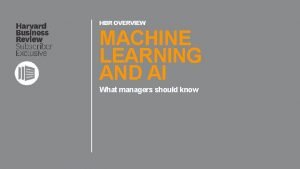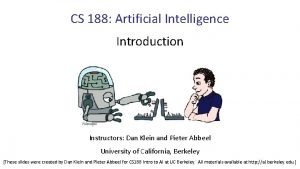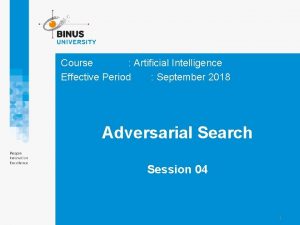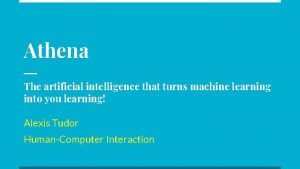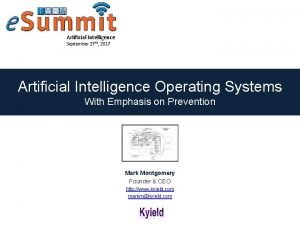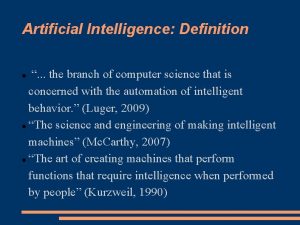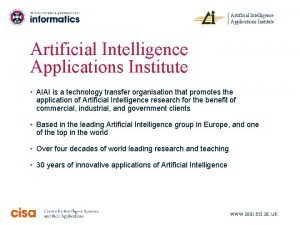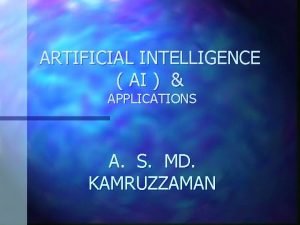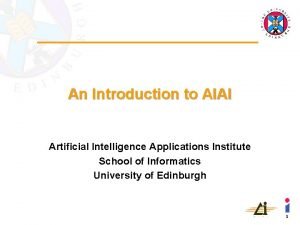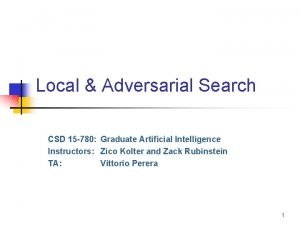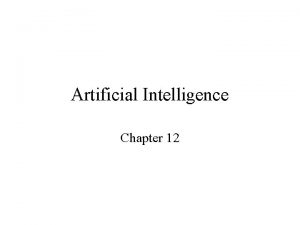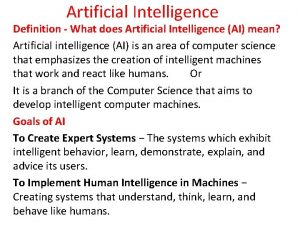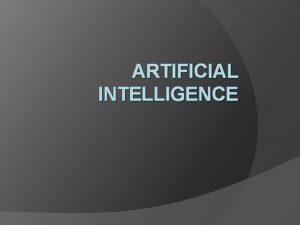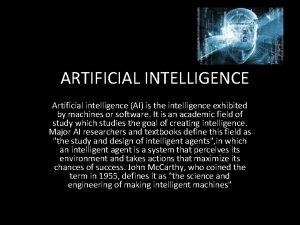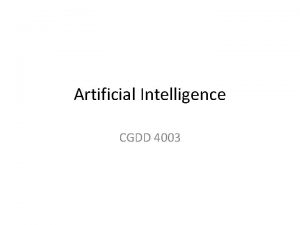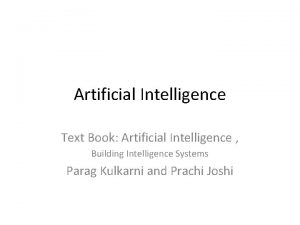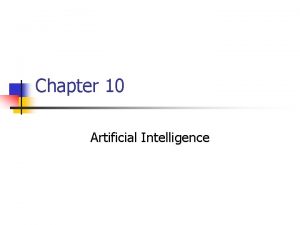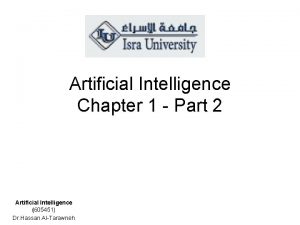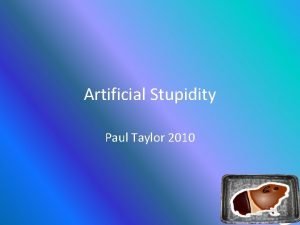Artificial Intelligence Chapter 12 Definition Artificial Intelligence AI













































- Slides: 45

Artificial Intelligence Chapter 12

Definition: • Artificial Intelligence (AI): – “The activity of providing such machines as computers the ability to display behavior that would be regarded as intelligent if it were observed in humans. ”

AI ARTIFICIAL INTELLIGENCE (AI) SYSTEMS: (Laudon & Laudon Definition) AI: COMPUTER-BASED SYSTEMS WITH ABILITIES TO LEARN LANGUAGE, ACCOMPLISH TASKS, USE PERCEPTUAL APPARATUS, EMULATE HUMAN EXPERTISE & DECISION MAKING *

History of AI

1950 • Turing Test – "Can machines think? " • Loebner Prize – $100, 000 Grand Prize – Not yet awarded

1950: • Alan Turing proposes the “Turing Test” for computers • Can a computer pass for a human?

1952: • UNIVAC correctly predicts Dwight Eisenhower’s election with only 7% of votes reported •

1956: “Artificial Intelligence” • John Mc. Carthy coins the term in 1956 as theme of a conference held at Dartmouth College.

“Artificial Intelligence” • Dartmouth, 1956 • 25 -year Prediction (1981): – Prediction: in 25 years (1981) (would be before George Orwell’s 1984) – Intelligent machines would be able to do all the physical and intellectual work for human beings. – Leaving people to devote all their time to recreational activities.

1958: • John Mc. Carthy: • If we work really hard, we’ll have an intelligent system in from four to four hundred years.

1958: • Herbert Simon: • Said that a program would be chess champion in ten years (by 1968).

Deep Blue • 1997 IBM’s computer “Deep Blue” defeats world chess champion, Gary Kasparov. • First time a computer had defeated a top-ranked chess player • Not Undisputed

Major Areas of AI: • • Expert Systems Neural Networks Perceptive systems Robotics

AI EXPERT SYSTEMS KNOWLEDGE - INTENSIVE CAPTURES HUMAN EXPERTISE IN LIMITED DOMAINS OF KNOWLEDGE *

Development of Expert Systems • What is Expertise? – Skill and knowledge whose input into a process results in performance high above the norm.

First-to-100 -game • Rules: – 2 Players alternate by adding a number to the total. – Numbers must be within 1 -10. – First player to reach 100 wins

Following a Set of Rules / Pattern Recognition • The game can easily be won by anyone who recognizes the pattern… • You must be the first to 89 in order to be the first to 100…

Development of Expert Systems ® Components Systems of Expert ® The interface or dialog ® The knowledge base ® The interface engine

Development of Expert Systems Components of an expert system; numbers indicate the order of the processes

Expert Systems • The Benefits – Longevity – Cost savings – Availability – Replicable

Contribution of Expert Systems • Areas where ESs can help in business – – – – – Planning Decision making Monitoring Diagnosis Training Incidental learning Replication of expertise Timely response Consistent solutions

Contribution of Expert Systems Major reasons for using expert systems

Expert Systems in Action • Business areas using ESs – – – Telephone network maintenance Credit evaluation Tax planning Detection of insider securities trading Mineral exploration – Legal Advice/ Medical Advice – Visa & M/C: 2 purchases + 1 Gas out of town: call for verification

Knowledge Representation Methods • Factors Justifying the Acquisition of Expert Systems

AI • • EXPERT SYSTEMS LIMITATIONS: Often reduced to problems of classification Can be large, lengthy, expensive Maintaining knowledge base critical Many managers unwilling to trust such systems *

Limitations of Expert Systems • Three limitations of ESs – Can handle only narrow domains – Do not possess common sense – Have a limited ability to learn

Bobs Cars • Simple A. I. Application based on weights +/ - w/ each choice you make • http: //www. src-net. com/Bobs. Cars/fbdeal. htm

AI: Neural Networks

Neural Networks • Biologically inspired flexible statistical models. • Function approximations – Offers not only point estimates but also converges on the derivatives of the unknown functions

Neural Networks • A mathematical model of the human brain that simulates the way that neurons interact to process data and learn from experience.

Human Neurons • Dendrites (input) • Soma (processor) • Axons (output)

Biological Neural Network • Patterns of electrical impulses from cell to cell form memory.

From Biological to Artificial Neural Networks Neural nets simulate the association and inference that take place in a network of neurons in the human brain. Instead of a network of neurons, a network of nodes is developed.

Artificial Neuron • Y is the result of the weighted input signals • Any non-linear function can be used, the Sigmoid function is the most popular

Multi-Layered Artificial Neural Network (A. N. N. ) • All possible interactions are considered • All relationships are considered non-linear • High inter-correlation is not a problem

Specific Examples of A. N. N. • • • Bankruptcy Prediction Forecasting Stock Prices Direct Marketing Mail Prediction Credit Scoring Real Estate Appraisal Finding Gold (testing soil samples) Thoroughbred Horse Racing: 17 wins in 22 races Weather Forecasting Beer Testing Credit Card Fraud Detection • Mars-Rock testing

Neural Network Simulator for Character Recognition http: //diwww. epfl. ch/mantra/tutorial/english/ocr/html/index. html

AI: Ethical and Societal Issues

Ethical and Societal Issues Too Sophisticated Technology • Increasing dependence on machine intelligence raises legal and ethical issues. – Who is legally responsible for advice provided by a program? – Is expert judgment needed to interpret program output? – Does machine expertise replace or complement the ‘real thing’? – How do we know if the experts behind expert systems are expert at all?

Ethical and Societal Issues Too Sophisticated Technology • Malfunctions of an ES can be caused by anyone involved in the development. – Experts who contribute knowledge – Knowledge engineer who builds the system – Professional who uses the ES – The person who is affected by the decision

British Telecom • “Soul Catcher” • Implant a microchip in the human brain

Questions?

Needed Links:

Bobs Cars • Simple A. I. Application based on weights +/ - w/ each choice you make • http: //www. src-net. com/Bobs. Cars/fbdeal. htm

Neural Network Simulator for Character Recognition http: //diwww. epfl. ch/mantra/tutorial/english/ocr/html/index. html
 Artificial intelligence chapter 3
Artificial intelligence chapter 3 Artificial intelligence chapter 1
Artificial intelligence chapter 1 Artificial intelligence chapter 1
Artificial intelligence chapter 1 Artificial intelligence chapter 1
Artificial intelligence chapter 1 Dart expert system
Dart expert system State space search
State space search Searching for solutions in artificial intelligence
Searching for solutions in artificial intelligence 15-780 graduate artificial intelligence
15-780 graduate artificial intelligence Knowledge manipulation in ai
Knowledge manipulation in ai What is meta knowledge in artificial intelligence
What is meta knowledge in artificial intelligence Vandelay art. seinfeld the show about nothing. penguin 1997
Vandelay art. seinfeld the show about nothing. penguin 1997 Artificial intelligence leadership
Artificial intelligence leadership Artificial intelligence assessment
Artificial intelligence assessment Math and artificial intelligence
Math and artificial intelligence Peas model example
Peas model example 15-780 graduate artificial intelligence
15-780 graduate artificial intelligence Xkcd deep learning
Xkcd deep learning The number of fuzzy propositions
The number of fuzzy propositions Cse 571
Cse 571 15 780
15 780 Informed and uninformed search
Informed and uninformed search What is artificial intelligence class 6
What is artificial intelligence class 6 Augmented grammar in artificial intelligence
Augmented grammar in artificial intelligence Omniscience in artificial intelligence
Omniscience in artificial intelligence Int 404
Int 404 Partitioned semantic network in artificial intelligence
Partitioned semantic network in artificial intelligence Ao* algorithm example
Ao* algorithm example Artificial intelligence thesis proposals
Artificial intelligence thesis proposals Rule based deduction system in artificial intelligence
Rule based deduction system in artificial intelligence Inference by enumeration in artificial intelligence
Inference by enumeration in artificial intelligence Learning in ai
Learning in ai Ucs
Ucs Introduction to artificial intelligence and expert systems
Introduction to artificial intelligence and expert systems Optimal decisions in games in artificial intelligence
Optimal decisions in games in artificial intelligence Andrew ng hbr
Andrew ng hbr Cs188 artificial intelligence
Cs188 artificial intelligence Optimal decisions in games in artificial intelligence
Optimal decisions in games in artificial intelligence Athena artificial intelligence
Athena artificial intelligence Types of artificial intelligencel
Types of artificial intelligencel Using logic
Using logic Ai is a branch of computer science
Ai is a branch of computer science Artificial intelligence applications institute
Artificial intelligence applications institute Conclusion of artificial intelligence
Conclusion of artificial intelligence Artificial intelligence applications institute
Artificial intelligence applications institute Which search strategy is also called as blind search?
Which search strategy is also called as blind search? 15-780 graduate artificial intelligence
15-780 graduate artificial intelligence

